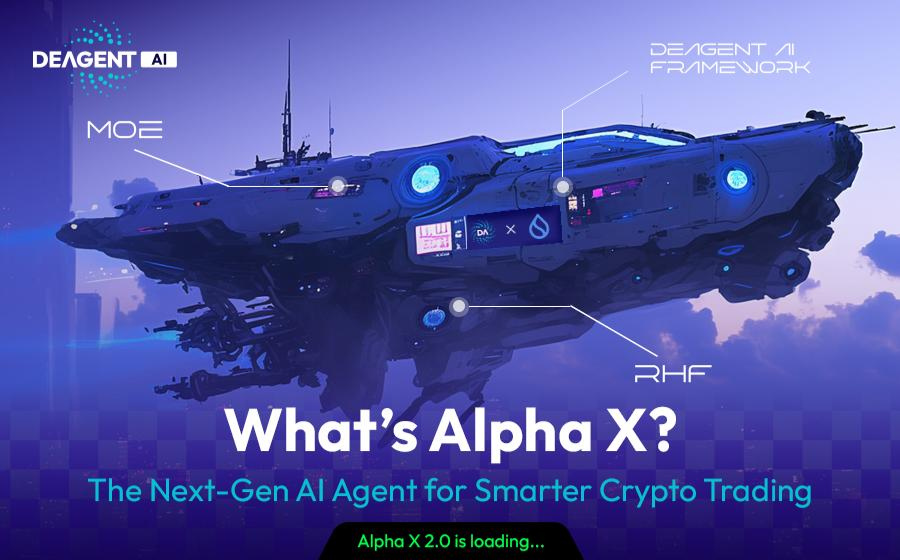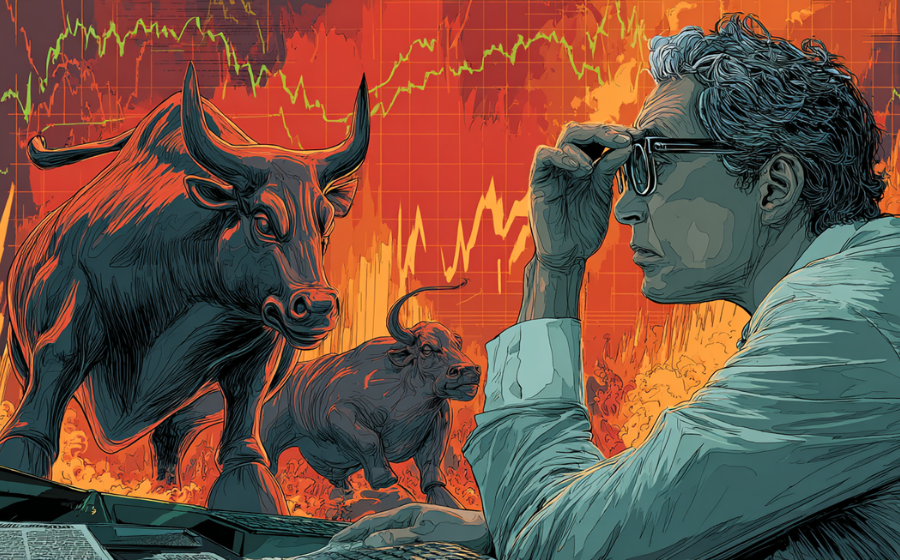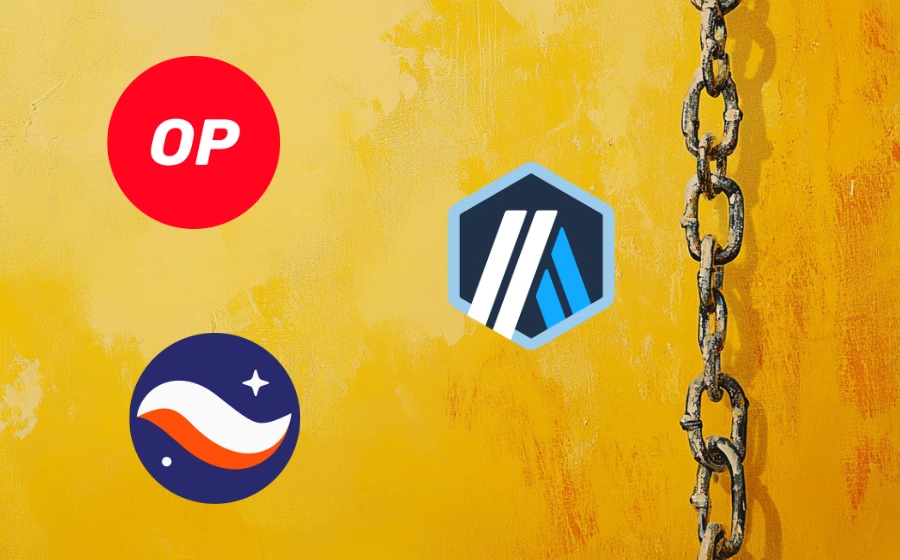
KEYTAKEAWAYS
- AlphaX 1.0 achieved 72.3% accuracy in crypto price predictions by combining Transformer architecture, Mixture-of-Experts technology, and Reinforcement Learning from Human Feedback mechanisms.
- AlphaX 2.0 introduces the DeAgentAI framework to solve identity, continuity, and consensus challenges in blockchain environments through on-chain states and entropy function mechanisms.
- The integration of specialized MoE capabilities, human-aligned RHF training, and DeAgentAI's robust framework positions AlphaX as a potential autonomous decision-maker in crypto trading.

- KEY TAKEAWAYS
- INTRODUCTION: PIONEERING AI EMPOWERMENT IN THE CRYPTO MARKET
- ALPHAX 1.0 TECHNOLOGY ARCHITECTURE ANALYSIS: LAYING THE FOUNDATION FOR INTELLIGENT PREDICTION
- DEAGENTAI INTELLIGENT DECISION FRAMEWORK: BUILDING THE INTELLIGENT CORE OF ALPHAX 2.0
- CONCLUSION: IS ALPHAX 2.0 READY TO REDEFINE AI-DRIVEN CRYPTO INVESTMENT?
- DISCLAIMER
- WRITER’S INTRO
CONTENT
AlphaX pioneers AI-driven crypto trading solutions, evolving from version 1.0’s Transformer and MoE foundation to version 2.0’s groundbreaking DeAgentAI framework that addresses core challenges in blockchain environments.
**Editorial content in partnership with DeAgentAI. Views expressed do not reflect those of CoinRank. Not financial advice.
INTRODUCTION: PIONEERING AI EMPOWERMENT IN THE CRYPTO MARKET
In the crypto market, notorious for its high volatility and complexity, traditional analytical tools and trading strategies have long struggled to keep pace with its rapid evolution. Consequently, AI-driven crypto solutions have become a key focus for Web3 projects, and AlphaX stands out as a frontrunner in this wave. Since its inception, AlphaX has been dedicated to revolutionizing cryptocurrency trading through AI technology, focusing on providing precise price predictions and automated trading strategies. As the integration of artificial intelligence and blockchain technology deepens, AlphaX is leading a new paradigm in intelligent trading with its forward-thinking technological layout and continuous innovation.
ALPHAX 1.0 TECHNOLOGY ARCHITECTURE ANALYSIS: LAYING THE FOUNDATION FOR INTELLIGENT PREDICTION
In August 2024, AlphaX 1.0 was officially launched, pioneering the combination of the Transformer architecture with Mixture-of-Experts (MoE) technology and introducing a Reinforcement Learning from Human Feedback (RLHF) mechanism. This created an industry-leading AI-driven on-chain trading prediction system. These three core technologies synergistically empowered AlphaX 1.0, making it a highly accurate and robust prediction tool.
- Transformer: The Foundational Model for AI Trade Prediction
As a revolutionary architecture in deep learning, the Transformer, with its powerful context modeling and data representation capabilities, became one of AlphaX 1.0’s core engines. Its unique attention mechanism effectively captures long-range dependencies in sequential data, enabling the precise excavation of complex and subtle logical relationships behind crypto market price fluctuations.
- Mixture-of-Experts (MoE): A Precisely Organized Network of AI Specialists
Building on the Transformer foundation, AlphaX integrated MoE model optimization technology. MoE employs a “divide and conquer” strategy, fundamentally changing how traditional dense models operate. Instead of a single, monolithic AI model, MoE utilizes multiple smaller, more specialized “expert” sub-models. A “gating network” dynamically assigns tasks to the most relevant expert(s) based on input data characteristics. This architecture offers several significant advantages: enhanced performance and efficiency, deep specialization, and greater scalability and flexibility, making it a natural fit for the highly heterogeneous and volatile crypto market.
- Reinforcement Learning from Human Feedback (RHF): Intelligent Training Symbiotic with the Market
From its early stages, AlphaX 1.0 adopted an RHF training mechanism. Through its simulated trading platform, AlphaX collected valuable human feedback data, including user intuition, strategy preferences, and market sentiment during actual trading decisions, to continuously optimize its AI model. The RHF process, encompassing Supervised Fine-Tuning (SFT), training a reward model, and reinforcement learning fine-tuning, effectively mitigates the issue of AI objectives misaligning with human intent, allowing the AI to learn nuanced trading intuition and market wisdom that is difficult to encode explicitly.
Empirical data shows that AlphaX 1.0 achieved an accuracy rate of 72.3% in predicting crypto market price trends within a 2 to 72-hour window. Its on-chain interaction volume surpassed an astounding 191 million. This high level of user activity and broad market recognition established AlphaX as a rare example of a truly practical AI-driven trading model in the crypto market.
DEAGENTAI INTELLIGENT DECISION FRAMEWORK: BUILDING THE INTELLIGENT CORE OF ALPHAX 2.0
The advent of AlphaX 2.0 represents a forward-looking exploration and practical application of the deep integration between artificial intelligence and crypto finance. It not only seamlessly continues the profound technological advancements of AlphaX 1.0 in MoE architecture and RHF training but also, through comprehensive integration with the groundbreaking DeAgentAI intelligent decision framework, aims to overcome the core challenges faced by AI in distributed environments (especially blockchain): Identity, Continuity, and Consensus. Consequently, AlphaX 2.0 achieves a qualitative leap in decision-making stability, trustworthiness, and transparency.
- Identity: DeAgentAI ensures a unique and deterministic identity and state for the AI agent at any given moment through on-chain state and strict consensus mechanisms, preventing conflicting decisions.
- Continuity: DeAgentAI stores and retrieves memory data (long-term and short-term) within the distributed network, enabling the AI’s historical decisions and learning processes to continuously influence subsequent actions.
- Consensus: The DeAgentAI framework introduces a unique Entropy Function mechanism. When multiple executors might produce different results for the same interaction, a network of Committers evaluates these candidate results using the entropy function (e.g., by calculating the negative dot product of input and output vector embeddings, – ( E(input) ⋅ E(output) )), selecting the result with the lowest entropy as the final consensus. This ensures AI decisions are made with high transparency and verifiability.
Supported by this robust underlying architecture, AlphaX 2.0 exhibits more stable and predictable performance than traditional AI models. The MoE model endows it with specialized, precise predictive capabilities, while the RHF mechanism deeply integrates collective human wisdom and market intuition. The DeAgentAI framework further elevates these capabilities: its A2A (Agent-to-Agent) protocol supports efficient collaboration among different “expert agents”; MPC (Multi-Party Computation) integration provides secure on-chain execution for trading actions; and the Entropy Function offers a verifiable confidence measure for predictions.
Imagine a complex trading decision scenario: An MoE expert identifies a high-risk, high-reward opportunity. An RHF-trained reward model adjusts the priority based on user risk preferences. This insight is shared and integrated with other agents via the A2A protocol. If a decision to execute is made, MPC ensures secure on-chain execution, while the entropy function quantifies the decision’s confidence. This synergy of MoE specialization, RHF alignment, and the powerful DeAgentAI framework charts an exciting path for next-generation AI in high-risk, complex applications like crypto asset trading.
CONCLUSION: IS ALPHAX 2.0 READY TO REDEFINE AI-DRIVEN CRYPTO INVESTMENT?
The emergence of AlphaX 2.0 is undoubtedly a bold and significant endeavor in the deep integration of AI technology and crypto finance. It serves as both a crucial validation of the technological path for autonomous AI trading systems and a profound exploration of AI’s potential in complex financial governance. The fusion of MoE’s precision, RHF’s alignment, and the DeAgentAI framework’s robustness constitutes its unique technological moat.
Of course, any cutting-edge technological innovation comes with challenges. No matter how advanced the AI model itself, it still requires effective trading strategies to be truly supportive. The current “trading strategy integration” bottleneck, while posing short-term uncertainty for AlphaX 2.0’s initial performance, also opens up broader opportunities for collaboration and autonomous learning.
Excitingly, AlphaX 2.0 is currently in an intensive internal testing phase. The team is diligently refining product details to ensure an optimal launch. It is believed that this highly anticipated AI autonomous trading system will officially meet users in the near future.
What AlphaX 2.0 embodies is not just another technological iteration but potentially a pivotal shift for AI in the financial domain—from a mere auxiliary tool to a key participant capable of autonomous decision-making and even governance. Whether it can truly lead the new wave of AI-driven crypto investment is something the market will keenly observe.















